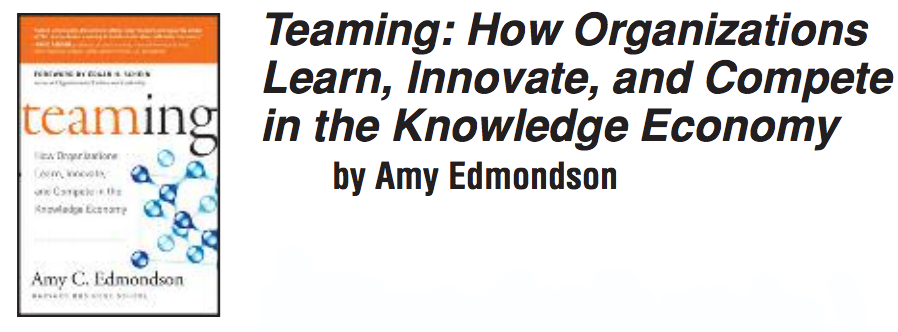
In Teaming: How Organizations Learn, Innovate, and Compete in the Knowledge Economy (Jossey-Bass, 2012), professor Amy Edmondson of Harvard Business School has crafted a practical, evidenced-based book on how leaders and organizations must approach the increasing complexity of the problems they face. Although the “execution mindset” was successful in the past, Professor Edmondson demonstrates that in an increasingly competitive global economy, a different approach is needed. She says, “For over a century, we’ve focused too much on relentless execution and depended too much on fear to get things done. That era is over. . . . Generating ideas to solve problems is the currency of the future; teaming is the way to develop, implement, and improve those ideas.”
Unlike formal teams that exist to serve specific functions, in teaming, people from a variety of functional areas fluidly come together to carry out short-term initiatives. The factors involved in leading effective teaming likewise differ from traditional leadership responsibilities and concerns. For instance, according to the author, individual and organizational psychology, hierarchical status, cultural differences, and physical distance can and do separate team members and prevent successful teaming. Leaders can close these gaps by understanding the existence of such obstacles and by adapting their leadership styles to overcome them.
TEAM TIP
In any initiative, take the time to build trust among team members—even if those individuals aren’t part of a formal team.
Professor Edmondson also notes that leaders must thoughtfully identify where the challenges they face fit on the Process Knowledge Spectrum—Routine Operations, Complex Operations, or Innovative Operations. A car manufacturing plant, where outcomes are fairly well known, is generally a Routine Operation. At the other extreme, in Innovative Operations such as an academic research lab, the outcomes are quite unknown. Although the teaming framework applies in each of these settings, the leader’s specific behaviors and actions must change. Having excellent outcomes and appropriate teaming requires matching the right approach to the specific kind of operation.
An Actionable Framework
Interestingly, conflict and failure are necessary for teaming to be successful and for maximum learning to occur. But these kinds of positive outcomes can take place only if leaders create an environment of psychological safety by framing failures as essential for continuous improvement and innovation.
Edmondson gives examples of instances when teaming has gone well (the improbable rescue in Chile of 33 miners after 69 days trapped underground) and not so well (the space shuttle Columbia tragedy). She also illustrates challenges and solutions with numerous case studies and insights from organizations such as Prudential, GM, Toyota, IDEO, the Internal Revenue Service, and several hospitals.
Professor Edmondson has woven 20 years of research and observation into an actionable framework and structure. Her findings and the stories she has captured make Teaming: How Organizations Learn, Innovate, and Compete in the Knowledge Economy compelling. It is destined to be a classic reference for leaders today and in the foreseeable future as they lead their colleagues and organizations into confronting and solving increasingly complex problems and challenges.
Dr. Davis Liu is a practicing family doctor and physician leader. He blogs regularly at www.davisliumd.com and is the author of The Thrifty Patient: Vital Insider Tips for Saving Money and Staying Healthy.
